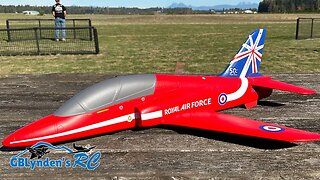Giant Scale Spitfire WWII Warbird RC Plane Take-Off Fail - Warbirds Over Whatcom County
I was very excited to see this plane fly last weekend at Warbirds Over Whatcom. This Giant Scale Spitfire WWII Warbird RC Plane has a reported 90" wingspan and is powered by a huge gas engine! This is a short but funny video featuring this remote control airplane.
Link to similar RC Planes: https://bit.ly/3Uio952
The links in this description are affiliate links. They give me a small commission on sales which helps support the channel and keep it independent: https://www.amazon.com/shop/gblyndensrc
Visit https://www.gblynden.com/ to learn more about the hobby!
RC Accessories:
- Spektrum Smart Checker: https://bit.ly/329hl12
- Spektrum IX20 Radio: https://amzn.to/3qFTbHe
- Spektrum AR620 Receiver: https://bit.ly/3Aay021
Other Fun RC Planes:
- Arrows Husky 1800mm PNP STOL RC Plane: https://bit.ly/3v3qQM9
- Arrows BAe Hawk EDF Jet: https://bit.ly/2VY0HB7
- Arrows T-33 EDF Jet: https://bit.ly/3h3Z24a
- Arrows F-86 EDF Jet: https://bit.ly/3hIli3C
- Arrows F-15 EDF Jet: https://bit.ly/3Cxi10D
- Arrows RC MiG-29 EDF Jet: https://bit.ly/2ZDmjBY
- Arrows RC Marlin EDF Jet: https://bit.ly/2LUe4cN
- Arrows T-28 Trojan RC Warbird: https://bit.ly/2LOr3N4
- Arrows Bigfoot RC Plane: https://bit.ly/2TJliVh
Watch what happens as he tries to take off! ;)
GB
Plane History:
The Supermarine Spitfire is a British single-seat fighter aircraft that was used by the Royal Air Force and many other Allied countries throughout the Second World War. The Spitfire continued to be used as a front line fighter and in secondary roles into the 1950s. It was produced in greater numbers than any other British aircraft and was the only British fighter in continuous production throughout the war.[5]
The Spitfire was designed as a short-range, high-performance interceptor aircraft[6] by R. J. Mitchell, chief designer at Supermarine Aviation Works (which operated as a subsidiary of Vickers-Armstrong from 1928). Mitchell continued to refine the design until his death from cancer in 1937, whereupon his colleague Joseph Smith became chief designer.[7] Where speed was seen as essential to carrying out the mission of home defense against enemy bombers,[6] the Spitfire's thin cross-section elliptical wing allowed it a higher top speed than several contemporary fighters, including the Hawker Hurricane.[8]
During the Battle of Britain (July--October 1940) in WWII, the Spitfire was perceived by the public as the RAF fighter, though the more numerous Hawker Hurricane shouldered a greater proportion of the burden against the Luftwaffe. The Spitfire units had a lower attrition rate and a higher victory-to-loss ratio than those flying Hurricanes during World War II.[9]
After the Battle of Britain, the Spitfire became the backbone of RAF Fighter Command, and saw action in the European, Mediterranean, Pacific and the South-East Asian theatres. Much loved by its pilots, the Spitfire served in several roles, including interceptor, photo-reconnaissance, fighter-bomber, carrier-based fighter, and trainer. It was built in many variants, using several wing configurations.[10] Although the original airframe was designed to be powered by a Rolls-Royce Merlin engine producing 1,030 hp (768 kW), it was adaptable enough to use increasingly powerful Merlin and later Rolls-Royce Griffon engines producing up to 2,035 hp (1,520 kW). Those are similar to what a P-51 Mustang would have for a motor[11]
-
 3:28
3:28
GBLynden's RC
7 months ago4S Maiden | Arrows RC BAe Hawk 50mm EDF Jet
135 -
 1:37:56
1:37:56
Barstool Yak
7 hours agoThe Yak with Big Cat & Co. Presented by Rhoback | The Yak 6-7-24
46.6K5 -
 39:43
39:43
Tactical Advisor
4 hours agoPart 2 Big Announcement - Vault Room Live Stream
31.5K6 -
 1:58:20
1:58:20
Russell Brand
6 hours agoMUST WATCH: “This Is The REAL Donald Trump” - RNC Spokesperson Reveals TRUTH About President Trump
138K296 -
 1:12:01
1:12:01
Michael Franzese
6 hours agoAmerica's FREEDOM and Democracy is under ATTACK! | Sitdown with Tulsi Gabbard
37.2K22 -
 35:43
35:43
Tate Speech by Andrew Tate
11 hours agoPETER PAN PEANUT BUTTER ALERT | EPISODE 9
136K145 -
 2:58:42
2:58:42
The Charlie Kirk Show
6 hours agoThe Unstoppable Donald Trump + The Left's Lawfare | LIVE 6.7.24
111K52 -
 2:04:59
2:04:59
The Quartering
22 hours agoBearing, TheQuartering & A Special Guest! TISM Episode 6-7-2024
86.8K16 -
 53:09
53:09
Talk Nerdy 2 Us
7 hours agoUS Economy on the Brink! Is World War III Around the Corner?
25.4K -
 57:48
57:48
The Dan Bongino Show
9 hours agoWho Is Going To Be Trump's VP? (Ep. 2266) - 06/07/2024
544K1.91K